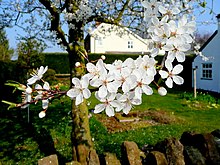A plum is a fruit of the subgenus Prunus of the genus Prunus. The subgenus is distinguished from other subgenera (peaches, cherries, bird cherries, etc.) in the shoots having a terminal bud and solitary side buds (not clustered), the flowers in groups of one to five together on short stems, and the fruit having a groove running down one side and a smooth stone (or pit).
Mature plum fruit may have a dusty-white coating that gives them a glaucous appearance. This is anepicuticular wax coating and is known as "wax bloom". Dried plum fruits are called dried plums or prunes, although prunes are a distinct type of plum, and may have antedated the fruits now commonly known as plums.
Species[edit]
Plum has many species, and taxonomists differ on the count. Depending on the taxonomist, between 19 to 40 species of plum exist. From this diversity only two species, the hexaploid European plum (Prunus domestica) and the diploid Japanese plum (Prunus salicina and hybrids), are of worldwide commercial significance. The origin of these commercially important species is uncertain but may have involved P. cerasifera and possibly P. spinosa as ancestors. Other species of plum variously originated in Europe, Asia and America.[4]
The subgenus Prunus is divided into three sections:
- Sect. Prunus (Old World plums)- leaves in bud rolled inwards; flowers 1-3 together; fruit smooth, often wax-bloomed
- P. cerasifera (cherry plum)
- P. cocomilia (Italian plum)
- P. consociiflora
- P. domestica (species of most "plums" and "prunes")
- P. domestica ssp. insititia (damsons,bullaces)
- P. simonii (widely cultivated in North China)[5]
- P. spinosa (blackthorn or sloe)
- Sect. Prunocerasus (New World plums) - leaves in bud folded inwards; flowers 3-5 together; fruit smooth, often wax-bloomed
- P. alleghaniensis (Allegheny plum)
- P. americana (American plum)
- P. angustifolia (Chickasaw plum)
- P. hortulana
- P. maritima (beach plum)
- P. mexicana (Mexican plum)
- P. nigra (Canada plum, Black plum)
- P. × orthosepala (P. americana × P. angustifolia)
- P. subcordata (Klamath, Oregon, or Sierra plum)
- Sect. Armeniaca (apricots) - leaves in bud rolled inwards; flowers very short-stalked; fruit velvety; treated as a distinct subgenus by some authors
- P. armeniaca (apricot)
- P. brigantina
- P. mandshurica
- P. mume (Chinese plum, Japanese apricot)
- P. sibirica (Siberian apricot)



No comments:
Post a Comment